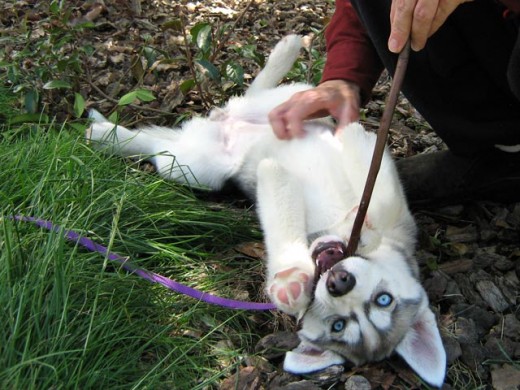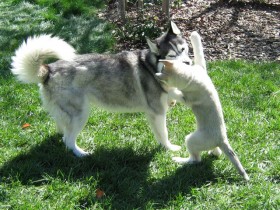To a puppy, everything is new, interesting, and exciting. This means that our puppy will try to bite, play with, and chew just about anything that he sees.
In addition, puppies have the infinite energy of youth. Like the Energizer Bunny, they can keep going, and going, and going. After a nap, their engines rev-up from SLEEP to GO, faster than you can catch your breath and shout “Stop!”.
Sound and movement are especially irresistible to a puppy.
The more we shout and move our hands, arms, or feet around, the more likely our puppy will get excited, bite, jump, and act even more crazy.
A very important part of training my puppy involves managing his excitement level, and teaching him self control. By doing this, I set my puppy up for success, and reduce out of control biting and jumping, before it occurs.
An ounce of prevention is worth a pound of cure.
~~[Benjamin Franklin]

1. Nothing in Life is Free (NILIF)

NILIF stands for Nothing in Life is Free. It is a great way to train a puppy, build a strong bond with him, and remain sane in the presence of our bouncing ball of fur.
NILIF is simple – we just ask our puppy to do something for us first, before we give him anything in return. This includes food, toys, freedom, and yes, even our affection.
First, I train my puppy to do some very simple commands. Here are three simple commands –

1. Look
Look simply asks a puppy to give us eye contact for a short amount of time.
- I train this command by showing my puppy that I have a piece of food.
- I say “Look”, and bring the food up to the level of my eyes.
- Puppy will naturally follow the movement of my food-enhanced hand, and look-up at me.
- As soon as he looks, I mark the behavior (Good!) and reward him with some food from my other hand.
- As my puppy improves, I get him to look at me for longer, before rewarding the behavior.
2. Touch
Touch asks a puppy to gently touch our hand with his nose.
- Again, I let my puppy see that I have some food in my hand.
- Then, I close my hand, move it a short distance away from my puppy, and say “Touch”.
- Puppy will naturally follow the food. At first, he may try to mouth or lick at my hand. I ignore these behaviors and wait until he touches my hand with his nose.
- As soon as that happens, I mark the behavior (Good!) and reward him with some food from my other hand.
3. Sit
Sit is a useful evergreen command. Even after our dog has matured into an adult, we will still find this command to be very handy.
- To train a Sit, I show my puppy that I have some food in my hand.
- I close my hand and move it over and above my puppy’s head. He will naturally want to follow my hand, which will cause him to turn his head up and move his rump down into a sitting position.
- Some dogs may move backwards instead of sitting. That is fine. I just repeat the motion until I get a Sit. However, it is important not to repeat the verbal command. I only say “Sit” once.
- As soon as my puppy sits, I mark the behavior (Good!), and give him a treat from my other hand.
Once my puppy understands these simple commands, I ask him to do something for me, before I do anything for him in return. For example,
- Ask for a Look, before giving a puppy affection or tummy rubs.
- Ask for a Sit, before we open the door for our puppy to go on his daily walk.
- Ask for a Touch, before we give a puppy his interactive food toy.
This teaches our puppy that the best way to get what he wants, is to do what we want first. When my puppy bites, I no-mark the behavior (Ack-Ack) and give him an alternate command (e.g., Sit). This not only teaches our puppy what not to do (bite), but also what to do instead (sit).

2. Drag Lead


Sometimes, puppies get so excited while playing, that they are no longer able to listen to us. In general, I try to step in and have a play break before this happens. However, we may sometimes miss our window of opportunity, and our puppy becomes so excited that he will not stop biting or jumping.
In such situations, I find that it is extremely useful to have a drag lead on my puppy. By using a lead, I can easily control and stop his bad behavior.
Often, when a puppy bites, our instinct is to try and stop him by using our hands and arms. We push back, shout, and move-around a lot. All this hand and arm movement will only get him even more excited, because he thinks we are playing with him. Furthermore, rapid movement may trigger a dog’s prey drive and get him to bite more, and bite harder.
To stop a puppy from biting, it is important to stay calm, don’t shout, and not move in a fast and erratic fashion. Instead, I calmly pick up the drag lead and move my puppy into a quiet area, where he can calm down.
I use a flat collar with the drag lead. Do not use an aversive collar such as a choke chain or a prong. Such collars are risky. Some choose to use them during supervised walks, but they should always be removed at the end of the walk. I also cut the loop of my drag lead, so that it does not catch on furniture or objects in the house, while my puppy is running around. I only use a drag lead when I am around to supervise.

3. Lots of Exercise & Play

Puppies are extremely energetic and curious. As such, they often need a lot of activity and play time.
If we do not provide interesting and supervised activities for them to do, they will figure out their own activities which will rarely appeal to our human sensibilities. Bored puppies will start chewing on books, curtains, furniture, and people.
To reduce puppy biting, make sure to provide him with a lot of physical and mental stimulation.
Interactive food toys are a big favorite with my dogs. Instead of presenting food to them on a silver dog bowl, I put some of their food into interactive food toys. In this way, they are motivated to work on the toy, and they get mental and physical exercise while figuring out the best and fastest way to get at the food.
Daily walks will also help to drain a puppy’s energy. Make sure that a puppy has had all of his shots before taking him to areas where there are other dogs, and where there is poop from other dogs.
Puppies also love playing with other puppies. Nothing burns quite as much energy as a fun puppy chase and wrestling session. I make sure that all my puppy’s play-mates are balanced, healthy, and have had their requisite number of shots.
Other fun puppy games include soccer, catch, fetch, tug, and flirt pole.

4. Rules and Routine

Puppyhood is the best time to teach a dog new tricks. Puppies learn quickly, and are usually eager to please.
I set up a fixed routine for my puppy as early as possible, and also start enforcing a consistent set of house rules. My puppy routine includes food time, play time, walk time, chew time, grooming time, training time, and most important of all – sleep time. Puppy sleep time is when I get some much needed time-off, away from Energizer puppy. *Hooah!*
In the beginning, it is best to institute more house rules and to address them consistently. In this way, our puppy does not develop any bad habits, which will be hard to break later on.
My dogs have the following house rules –
- No getting on furniture.
- No biting on people or people stuff.
- No pawing on people.
- No guarding of toys or food.
- No bullying of other dogs.
Congratulations on your new puppy! Puppy time is precious and passes very quickly, so enjoy yourself and take lots of pictures. 😀

Hi I have 6 month old staffie and he keeps biting n jumping up ppl I have tryed alsorts 2 try stop this but nothing seem 2 be working he does listen though wen I say get in ur bed u naughty boy but thn he back 2 not listening